⇣ Content
GALAXY S series devices almost all the time of its existence, “traveled” solely due to the advanced technical features, combined with moderate – by the standards of the flagships – price. And finally, it’s time to change: I think that this year, some manufacturers will want to “circle» GALAXY S6 Edge. But is this machine more than others.
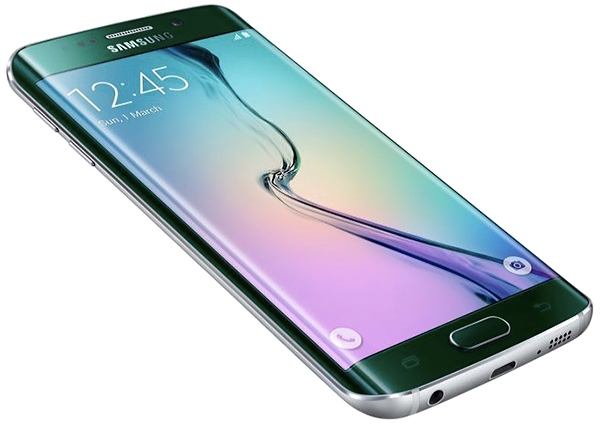
Samsung GALAXY S6 Edge, an official photo
From the point of view of “iron “All too has changed dramatically over time GALAXY S5, although the policy remains the same: the new flagship of the best, most advanced. Smartphones S6 and S6 Edge boast Quad HD-display, the newest platform Exynos – 7420, the most advanced RAM LPDDR4, support LTE Cat. 6 and 16-megapixel camera. In general, a “full ground meat”, all with the latest technology. Is the new flagships so good? Let’s try to answer this question after a detailed test.
⇡ # Specifications
| Samsung GALAXY S5 | Samsung GALAXY S6 | Samsung GALAXY S6 Edge | |
|---|---|---|---|
| Touch screen | 5,1 inch, 1920 × 1080 pixels, AMOLED, 432 dots per inch; Capacitive up to ten simultaneous touches | 5,1 inch, 2560 × 1440 pixels, AMOLED 575,9 dpi; Capacitive up to ten simultaneous touches | 5,1 inch, curved at the sides, 2560 × 1440 pixels, AMOLED; 575.9 dpi; Capacitive up to ten simultaneous touches |
| Safety glass | Corning Gorilla Glass 3 | Corning Gorilla Glass 4 on both sides | Corning Gorilla Glass 4 on both sides |
| air gap | No | No | No |
| oleophobic coating | There | There | There |
| A polarizing filter | There | There | There |
| Factory film | No | No | No |
| processor | Qualcomm Snapdragon 801 MSM8974AC v3: quad-core Qualcomm Krait-400 (ARMv7, 32 bits), the frequency of 2.46 GHz; 28 nm process technology HPm | Samsung Exynos 7420: quad-core ARM Cortex-A57 (ARMv8, 64 bits), the frequency of 2.1 GHz; quad-core ARM Cortex-A53 (ARMv8, 64 bits), the frequency of 1.5 GHz; 14 nm process technology | Samsung Exynos 7420: four core ARM Cortex-A57 (ARMv8, 64 bits), the frequency of 2.1 GHz; quad-core ARM Cortex-A53 (ARMv8, 64 bits), the frequency of 1.5 GHz; 14 nm process technology |
| Graphics Controller | Qualcomm Adreno 330 | Mali-T760 MP8 | Mali-T760 MP8 |
| RAM memory | 2GB LPDDR3 | 3 GB LPDDR4 | 3 GB LPDDR4 |
| Flash memory | 16 GB (available to the user ~ 12GB) Connector for memory cards MicroSD | 32/64 / 128GB Connector for memory cards missing | 64/128 GB (on the test version to a 64 GB user available ~ 53.7 GB); Connector for memory cards missing |
| Connectors | 1 × Micro-USB 3.0 (MHL) 1 × headphone jack 3.5 mm 1 × Micro-SIM 1 × MicroSD | 1 × Micro-USB 2.0 (MHL) 1 × headphone jack 3.5 mm 1 × Nano-SIM | 1 × Micro-USB 2.0 (MHL) 1 × headphone jack 3.5 mm 1 × Nano-SIM |
| Cellular | 2G / 3G / 4G One SIM card format Micro-SIM | 2G / 3G / 4G One SIM card format Nano-SIM | 2G / 3G / 4G One symmetry card format Nano-SIM |
| Cellular 2G | GSM / GPRS / EDGE 850/900/1800/1900 MHz | GSM / GPRS / EDGE 850/900/1800/1900 MHz | GSM / GPRS / EDGE 850/900/1800/1900 MHz |
| Cellular 3G | HSDPA (42,2 / 5,76 Mbps / s) 850/900/1900/2100 MHz | HSPA (42,2 / 5,76 Mbit / s) 850/900/1900/2100 MHz | HSPA (42, 2 / 5.76 Mbit / s) 850/900/1900/2100 MHz |
| Cellular 4G | LTE FDD band 1, 2, 3, 5, 7, 8, 20 (2100/1900/1800/850 / 2600/900/800 MHz) LTE Cat. 3 (150/50 Mbit / s) | LTE FDD band 1, 2, 3, 4, 5, 7, 8, 12, 17, 20 (2100/1900/1800/1700/850 / 2600/900/700/800) LTE Cat. 6 (300/50 Mbit / s) | LTE FDD band 1, 2, 3, 4, 5, 7, 8, 12, 17, 20 (2100/1900/1800/1700/850 / 2600/900/700/800) LTE Cat. 6 (300/50 Mbit / s) |
| Wi-Fi | 802.11a / b / g / n / ac, 2,4 and 5 GHz | 802.11a / b / g / n / ac, 2,4 and 5 GHz | 802.11a / b / g / n / ac, 2,4 and 5 GHz |
| Bluetooth | 4.0 + A2DP | 4.1 + A2DP | 4.1 + A2DP |
| NFC | There | There | There |
| IR | There | There | There |
| Quick | GPS, A-GPS, GLONASS, BeiDou | GPS, A-GPS, GLONASS, BeiDou | GPS, A -GPS, GLONASS, BeiDou |
| Sensors | The ambient light sensor, proximity sensor accelerometer / gyroscope, magnetometer (digital compass), barometer, fingerprint sensor, pulse sensor | The ambient light sensor, proximity sensor, accelerometer / gyroscope, magnetometer (digital compass), barometer, fingerprint sensor, pulse sensor | The ambient light sensor, proximity sensor, accelerometer / gyroscope, magnetometer (digital compass), barometer, fingerprint sensor, pulse sensor |
| The main camera | 16 megapixel (5312×2988), CMOS-matrix Samsung S5K2P2 size 1 / 2.6 ” on the back-illuminated technology and ISOCELL size element 1,12 μm; autofocus, LED flash single | 16 megapixel (5312 × 2988), BSI-matrix Sony IMX240 size 1 / 2.6 ” on the back-illuminated, the element size of 1.2 μm; optical stabilization system; Autofocus, LED flash single | 16 Mp (5312 × 2988), BSI-matrix Sony IMX240 size 1 / 2.6 ” on the back-illuminated, element size 1,2 μm; optical stabilization system; Autofocus, LED flash single |
| The front camera | 2 megapixel (1920×1080) , no autofocus, no flash | 5 megapixel (2592 × 1944), no autofocus, no flash | 5 megapixel (2592 × 1944), no autofocus, no flash |
| Power | Removable battery 10.78 Wh (2800 mAh, 3 , 85) | Fixed battery 9.69 Wh (2550 mAh, 3.8 V) | Fixed battery 9.88 Wh (2600 mAh , 3.8 V) |
| Size | 142 × 73 mm Thickness Housing: 8.3 mm | 143 × 70,5 mm Case Thickness: 6.8 mm | 142 × 70 mm Case Thickness: 7 mm |
| Weight | 145 g | 138 g | 132 g |
| Protection Corps | IP67 | No | No |
| Operating System | Google Android 4.4.2 (KitKat ) own shell Samsung TouchWiz | Google Android 5.0.2 (Lollipop) own shell Samsung TouchWiz | Google Android 5.0.2 (Lollipop) > En shell Samsung TouchWiz |
| Current price | 29 990 rubles | 49 990 rubles | 56 990 rubles |
The only major difference between the Samsung GALAXY S6 and S6 Edge – in display and design: from the first device screen is quite standard, and the second – curved sides. Otherwise, the device is very similar to each other, but are not absolutely identical. There is a small difference in dimensions: thickness of the shell in the regular version – 6.8 millimeters, while the Edge – 7 millimeters. But modification with a rounded display a little easier – 132 against 138 grams. Finally, different batteries are used: 9.69 Wh (2550 mAh, 3.8 V) and in the normal version 9.88 Wh (2600 mAh, 3.8 V) from the Edge. It should also be noted that the version Samsung GALAXY S6 Edge 32 GB internal flash memory exists – with only 64 or 128 Gbytes. The rest of the S6 and S6 Edge identical in technical stuffing.
⇡ # Appearance and ergonomics
All of the Samsung device somehow similar. They have similar proportions of the body, about the same radius corners, oblong central key at the bottom of the front panel … well, a smartphone from Samsung always easy to find. The situation has not changed in appearance GALAXY S6 / S6 Edge remained very specific – even if you see this couple for the first time, you will be easy to guess that before you Samsung.
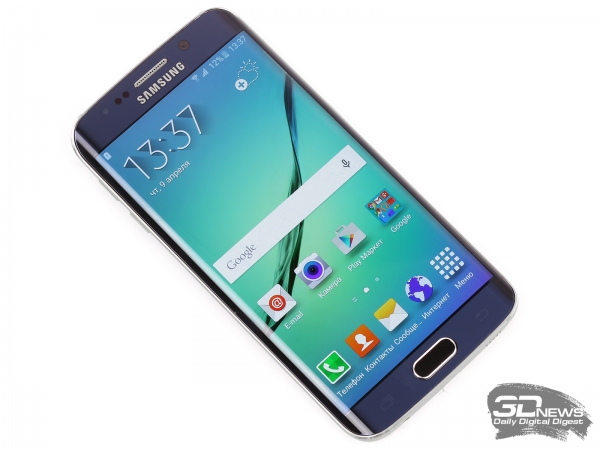
Meet, Samsung GALAXY S6 Edge
However predecessors GALAXY S6 / S6 Edge differ dramatically. So much so that, if there are parallels, we can say that the S6 and S6 Edge – it’s not even “restyling” is a complete new “body” for the flagship Samsung. Designers and engineers have finally abandoned in favor of the use of plastic metal and glass. This is perhaps the key difference S6 / S6 Edge from its predecessors. The front and rear panels on both sides are covered with protective glass Corning Gorilla Glass is relatively new, fourth generation. For the first time it is, by the way, was used in the “Phablet» Samsung GALAXY Note 4 – the first serial device company with a curved screen. Glass panel completely protects the gadget from scratches and other minor injuries.
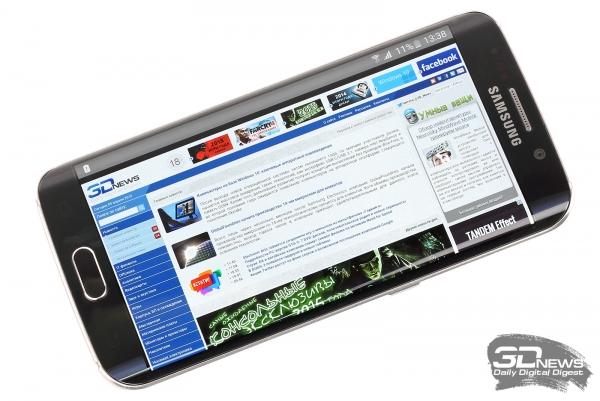
Samsung GALAXY S6 Edge with the included screen
GALAXY S6 Edge comes in four colors: Black Sapphire, Gold Platinum, White Pearl and exclusive Green Emerald. Order device in the company’s green in Russia, unfortunately, that is impossible. We tested came gadget color “Black Sapphire”. In our view, this is a very good color. Smartphone looks black, but when it gets light, appears dark blue gleam. In general, the phrase “dark blue metallic” is much better and more accurately characterizes the color than the “Black Sapphire”. It should be borne in mind that the “ordinary» GALAXY S6 other body colors.
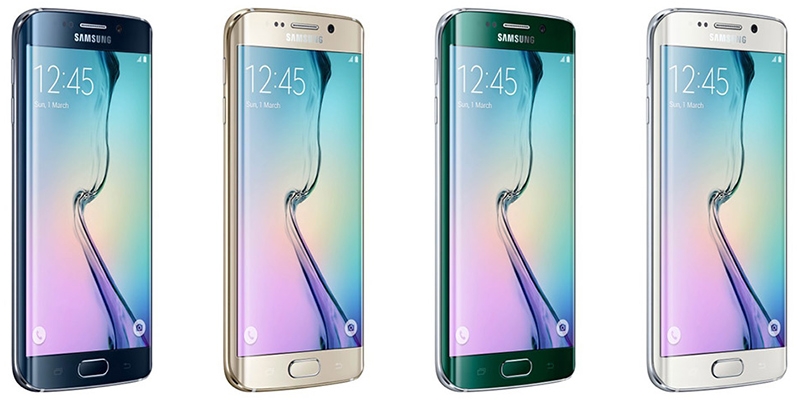
Samsung GALAXY S6 Edge – available colors
Keep out of the hands of Samsung GALAXY S6 Edge nice. The gadget is quite convenient to manage with one hand and hold it to shift the second will not have to – well, that Samsung decided not to increase the size of the screen compared to the GALAXY S5. Yes, the display is 5.1 inches, which by modern standards, not so much. The device does not slip in your hands, although the panel had a pretty smooth. During operation, the hand one way or another touches “sidewall” screen, but these false pressing gadget absolutely does not react. Perhaps they are blocked at the program level.
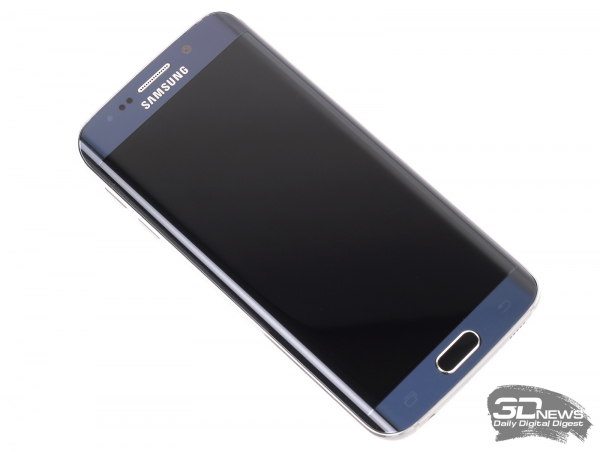
Samsung GALAXY S6 Edge – front panel
Locating Controls and Ports quite standard – plus or minus is the same as in the previous devices Samsung. Get used to your phone very easily. At the top of the front panel is the front lens, 5-megapixel camera, earpiece mesh, proximity sensor and the optocoupler LED.
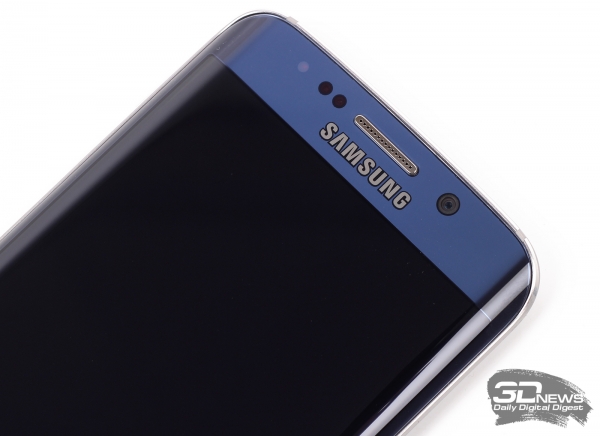
Samsung GALAXY S6 Edge – front Megapixel camera
At the bottom of the front panel is an oblong button “Home” with metal edging, which is integrated biometric sensor. Next to it are two standard touch-sensitive buttons, equipped with switchable backlight – “Menu open applications” and “Back».
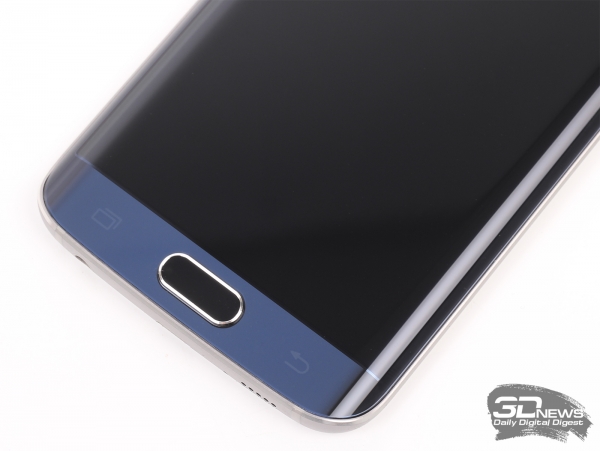
Samsung GALAXY S6 Edge – the central key “Home»
The shell thickness is not outstanding – seven millimeters (excluding the projecting lens back of the camera). Nevertheless, due to the tapering metal edging on the sides, creates a false sense that the smartphone is much thinner than stated.
Power key unit is moved to the right end of the thumb, and volume control buttons – the left . The keys are made of metal, with a short and distinct way. Tray for SIM-cards Nano-SIM format is hiding on the top, and next to it is the infrared port to control home appliances.
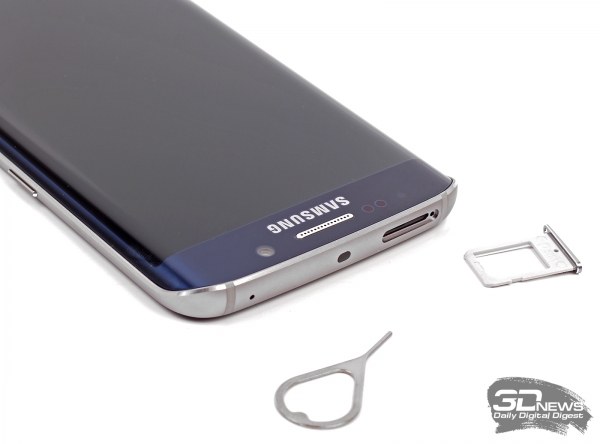
Samsung GALAXY S6 Edge – upper end
slot external speaker put to the bottom end. Placing his successful – during the operation he did not overlap arm. Next to it is Micro-USB interface combined with video output (MHL), as well as a universal 3.5 mm jack for connecting a wired headset.
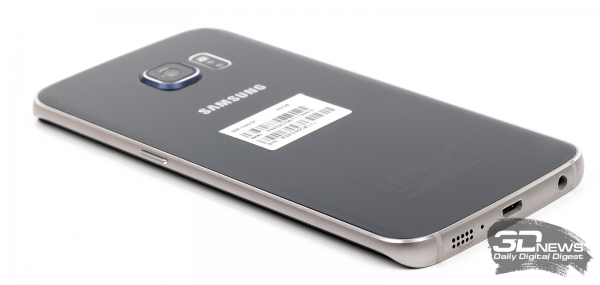
Samsung GALAXY S6 Edge – lower end
The rear panel houses the main lens, 16-megapixel camera with LED flash, as well as heart rate sensor. Panel pretty stamps – it gets dirty pretty fast and very willing to collect fingerprints. However, to get rid of them, you can use any improvised cloth. The casing is molded unit.
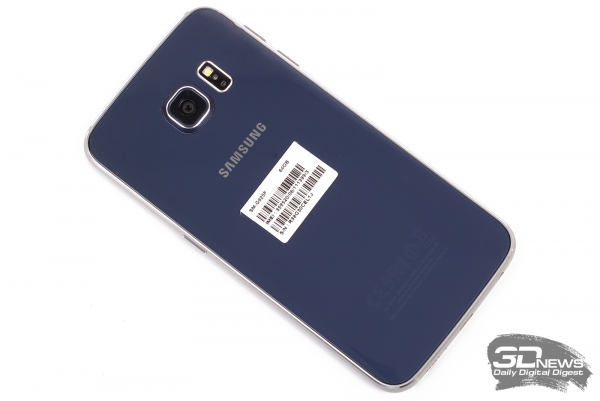
Samsung GALAXY S6 Edge – back panel. Peel the sticker with bar codes – the whole thing
Next page →
If you notice an error – highlight it with the mouse and press CTRL + ENTER.
Share: & nbsp ; & nbsp;
No comments:
Post a Comment